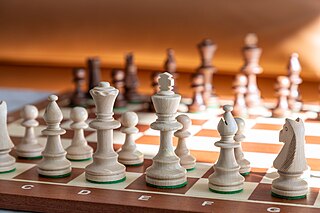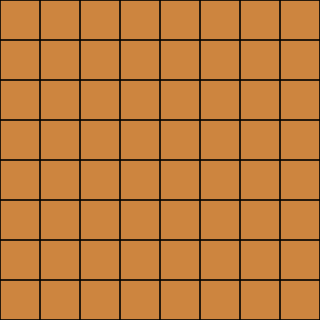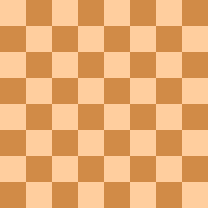
The queen is the most powerful piece in the game of chess. It can move any number of squares vertically, horizontally or diagonally, combining the powers of the rook and bishop. Each player starts the game with one queen, placed in the middle of the first rank next to the king. Because the queen is the strongest piece, a pawn is promoted to a queen in the vast majority of cases.

A chess piece, or chessman, is a game piece that is placed on a chessboard to play the game of chess. It can be either white or black, and it can be one of six types: king, queen, rook, bishop, knight, or pawn.

Algebraic notation is the standard method for recording and describing the moves in a game of chess. It is based on a system of coordinates to uniquely identify each square on the board. It is now almost universally used by books, magazines, newspapers and software, and is the only form of notation recognized by FIDE, the international chess governing body.

The rules of chess govern the play of the game of chess. Chess is a two-player abstract strategy board game. Each player controls sixteen pieces of six types on a chessboard. Each type of piece moves in a distinct way. The object of the game is to checkmate the opponent's king; checkmate occurs when a king is threatened with capture and has no escape. A game can end in various ways besides checkmate: a player can resign, and there are several ways a game can end in a draw.
Capablanca chess is a chess variant invented in the 1920s by World Chess Champion José Raúl Capablanca. It incorporates two new pieces and is played on a 10×8 board. Capablanca believed that chess would be played out in a few decades. This threat of "draw death" for chess was his main motivation for creating a more complex version of the game.
A fairy chess piece, variant chess piece, unorthodox chess piece, or heterodox chess piece is a chess piece not used in conventional chess but incorporated into certain chess variants and some unorthodox chess problems, known as fairy chess. Compared to conventional pieces, fairy pieces vary mostly in the way they move, but they may also follow special rules for capturing, promotions, etc. Because of the distributed and uncoordinated nature of unorthodox chess development, the same piece can have different names, and different pieces can have the same name in various contexts.

Makruk, or Thai chess, is a strategy board game that is descended from the 6th-century Indian game of chaturanga or a close relative thereof, and is therefore related to chess. It is part of the family of chess variants.

Sittuyin, also known as Burmese chess, is a strategy board game created in Myanmar. It is a direct offspring of the Indian game of chaturanga, which arrived in Myanmar in the 8th century thus it is part of the same family of games such as chess, and shogi. Sit is the modern Burmese word for "army" or "war"; the word sittuyin can be translated as "representation of the four characteristics of army"—chariot, elephant, cavalry and infantry.
Tamerlane chess is a medieval chess variant. Like modern chess, it is derived from shatranj. It was developed in Central Asia during the reign of Emperor Timur, and its invention is also attributed to him. Because Tamerlane chess is a larger variant of chaturanga, it is also called Shatranj Al-Kabir, as opposed to Shatranj as-saghir. Although the game is similar to modern chess, it is distinctive in that there are varieties of pawn, each of which promotes in its own way.
Yari shogi is a modern variant of shogi ; however, it is not Japanese. It was invented in 1981 by Christian Freeling of the Netherlands. This game accentuates shogi’s intrinsically forward range of direction by giving most of the pieces the ability to move any number of free squares orthogonally forward like a shogi lance. The opposite is true of promoted pieces which can move backward with the same power.

Hasami shogi is a variant of shogi. The game has two main variants, and all Hasami variants, unlike other shogi variants, use only one type of piece, and the winning objective is not checkmate. One main variant involves capturing all but one of the opponent's men; the other involves building an unbroken vertical or horizontal chain of five-in-a-row.
Ming mang is a two-player abstract strategy board game from Tibet. Ming mang is also a general term for the word "boardgame" in Tibet. The correct name and spelling of the game may actually be Mig mang(s), but pronounced Ming mang or Mi Mang. The term mig mang is also applied to Tibetan go with both games using exactly the same board which is a 17 x 17 square board, and black and white pieces. Mig is in reference to the chart of the board, and Mangs refers to the notion that the more charts are used on the board, the more pieces are needed to play the game, but some state that it means "many eyes". The game may also be known as Gundru. The game was popular among some Tibetan monks before the Chinese invasion of Tibet in 1950, and the uprising in 1959, and among aristocratic families.
Jul-gonu is a two-player abstract strategy board game from Korea. It is one of many gonu games. The game has a relatively small board, and yet offers a challenge at different levels. The game could be played on a larger board, however, it tends to be tiresome. Jul means "lines", and the lines of the board are often drawn on the ground. The game is also referred to as "ne-jul-gonu", i.e. "four-lines gonu", referring to the four lines in each direction.
Leap Frog, also known as Leapfrog, is a multi-player abstract strategy board game that was described by H.J.R. Murray in A History of Board Games Other Than Chess (1898) and attributes its origin to England. Several variants have been created including one by Murray himself which utilizes different colored pieces with alternative point values. In the traditional game, players take any piece on the board and use it to hop over and capture other pieces. When no more pieces can be captured, the game ends, and the player with the most pieces is the winner. Murray includes it in the section called Clearance Games which has the game Solitaire. It resembles Solitaire in many ways except that Solitaire is typically only played by one person.
Tiger game played with forty, translation of meurimueng-rimueng peuet ploh, is a two-player abstract strategy board game from Sumatra, Indonesia. The last part of the name, ploh, is sometimes spelled "plo". It is specifically played by the Acehnese. The game was described in The Achehnese by Hurgronje, O'Sullivan, and Wilkinson in 1906 and described on page 204.
Sua ghin gnua is a two-player abstract strategy board game from Thailand, formerly known as Siam. Another name for the game is tigers and oxen. It is a hunt game played on a 5x5 square grid with only orthogonal lines. One player plays the three tigers, and the other player plays the twelve oxen. The board is empty in the beginning. Players first drop their pieces onto the board, and then are able to move them. The tigers can capture the oxen by the short leap as in draughts and alquerque, but the oxen attempt to elude and at the same time hem in the tiger. Sua Ghin Gnua most resembles the tiger hunt games such as bagh-chal, rimau-rimau, main tapal empat, catch the hare, and adugo since they all use a 5 x 5 square grid. But tiger games technically consist of a standard alquerque board which is a 5 x 5 square grid with several diagonal lines criss-crossing through it which are completely missing in sua ghin gnua. There are however some variants of catch the hare which have missing diagonal lines also. Another game that resembles sua ghin gnua is from Myanmar, called tiger and buffaloes, which is a hunt game consisting of a 4 x 4 square grid with no diagonal lines. Myanmar happens to border Thailand geographically so there might be a historical connection between the two games. Another game from Myanmar is lay gwet kyah that is presumed to be similar to sua ghin gnua. Sua ghin gnua was briefly described by Stewart Culin, in his book Chess and Playing Cards: Catalogue of Games and Implements for Divination Exhibited by the United States National Museum in Connection with the Department of Archaeology and Paleontology of the University of Pennsylvania at the Cotton States and International Exposition, Atlanta, Georgia 1895 (1898). It's also briefly mentioned by H.J.R. Murray in his book A History of Chess (1913). It was also described by R.C. Bell, in his book Board and Table Games from Many Civilizations (1969).

The following outline is provided as an overview of and topical guide to chess:
This glossary of board games explains commonly used terms in board games, in alphabetical order. For a list of board games, see List of board games; for terms specific to chess, see Glossary of chess; for terms specific to chess problems, see Glossary of chess problems.








